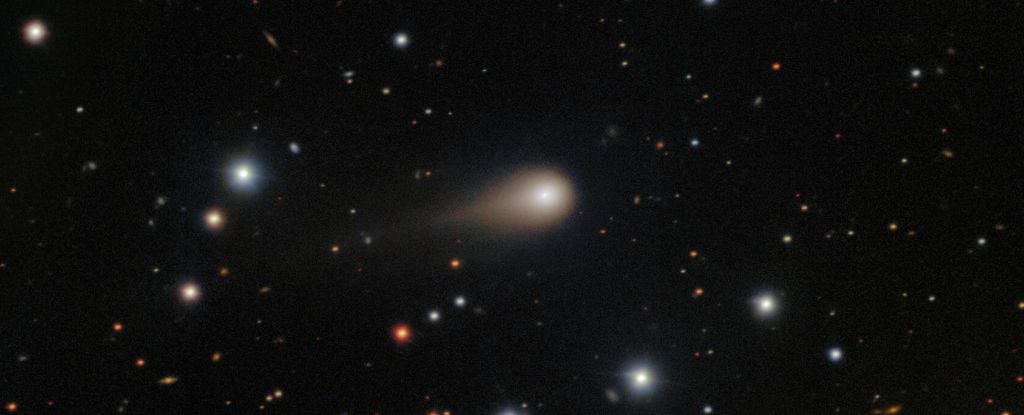Science
Spacecraft Hera and Europa Clipper Poised to Explore Comet 3I/ATLAS Tail

Two spacecraft, Hera and Europa Clipper, are set to pass through the tail of comet 3I/ATLAS, offering a unique opportunity to collect data from this interstellar object. According to a recent paper by researchers Samuel Grand and Geraint Jones, published in the Research Notes of the American Astronomical Society, both spacecraft are on trajectories that will place them near the comet’s tail within the next two weeks.
Hera, which is heading towards the binary asteroid Didymos-Dimorphos, will have a window for observation between October 25 and November 1. Europa Clipper, dedicated to studying the icy moon Europa of Jupiter, will be in position between October 30 and November 6. This timing aligns with the comet’s approach to perihelion, scheduled for October 29, 2023, when the tail is expected to be at its most active.
While both spacecraft were not originally designed for this type of observation, the researchers argue that they represent a significant chance to study the ions and water particles trailing behind 3I/ATLAS as it nears the Sun. The comet, discovered in early June, has been generating a growing tail, recently characterized by reports of “gushing” water.
Understanding the dynamics of the comet’s tail presents challenges. The solar wind affects the trajectory of particles emitted from the comet, pushing them into a curved path as they move through space. To estimate where the spacecraft might collect data, the authors employed a model named “Tailcatcher.” This model predicts the path of the comet’s ions based on solar wind speeds, helping to calculate the minimum miss distance for the spacecraft relative to the tail’s central axis. The estimations place Hera approximately 8.2 million kilometers and Europa Clipper around 8 million kilometers from the central axis of the tail.
Despite these distances, the researchers argue that collecting data is feasible. Active comets like 3I/ATLAS can have ion trails that extend over vast distances, potentially allowing the spacecraft to gather meaningful data. However, there are limitations. Hera lacks the necessary instruments to detect ions or the magnetic field changes associated with the comet’s atmosphere. In contrast, Europa Clipper is equipped with a plasma instrument and magnetometer, making it suitable for capturing the anticipated data.
The urgency of the situation cannot be understated. Mission controllers for both spacecraft will need to act quickly to capitalize on this unexpected opportunity. Whether they can coordinate an experiment in such a short timeframe remains uncertain. Should they successfully gather data from the tail of 3I/ATLAS, it would mark a historic first, allowing humanity to directly sample an interstellar comet’s tail.
The potential scientific insights from this endeavor could shed light on the nature of comets and the early solar system. As researchers continue to explore the mysteries of 3I/ATLAS, the collaboration of these missions exemplifies the spirit of innovation and adaptability in space exploration.
-

 Business4 days ago
Business4 days agoInvestors Eye Potential $60,000 Gains with Ozak AI Token
-

 Politics5 days ago
Politics5 days agoFormer Pastor Arrested on Human Trafficking and Indecent Charges
-

 Business5 days ago
Business5 days agoQuotient Wealth Partners Adjusts Holdings in iShares Russell 1000 ETF
-

 Lifestyle5 days ago
Lifestyle5 days agoNatty from KISS OF LIFE Stuns in Micro-Shorts at Seoul Event
-

 Politics4 days ago
Politics4 days agoSkip Bayless Critiques Travis Hunter’s Game Day Baptism
-

 Entertainment5 days ago
Entertainment5 days agoUtah Residents Face Resource Shortages Amid Ongoing Government Shutdown
-

 Business5 days ago
Business5 days agoCalifornia to Ban All Plastic Bags in Grocery Stores by 2026
-

 Entertainment5 days ago
Entertainment5 days agoPete Davidson Surprises Pregnant Girlfriend with Private Jet to Concert
-

 Entertainment5 days ago
Entertainment5 days agoAce Frehley, KISS Guitarist, Passes Away at 74 After Fall
-

 Politics5 days ago
Politics5 days agoIberia Parish Sees Surge in Marriage Licenses Issued in October
-

 Science5 days ago
Science5 days agoCommunity Mourns Loss of Judith Ernst, Pioneer Educator at 81
-

 Entertainment6 days ago
Entertainment6 days agoEastside Kings Festival Celebrates Austin’s Rich Blues and Jazz Heritage









